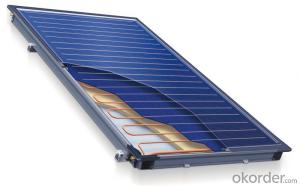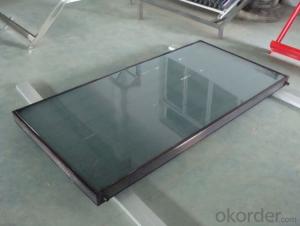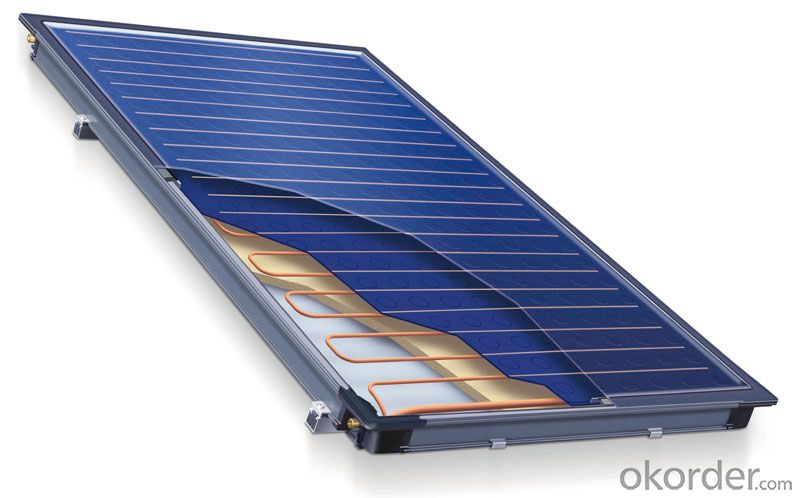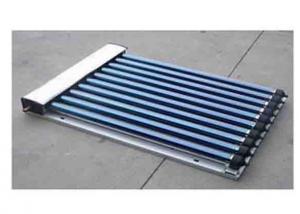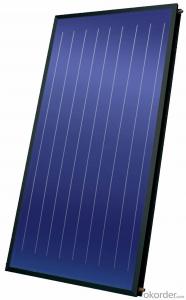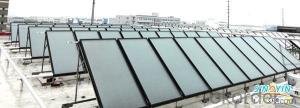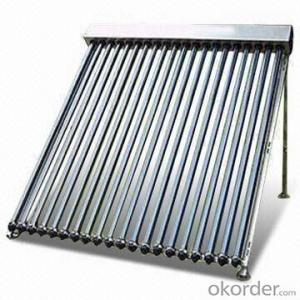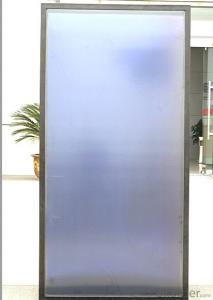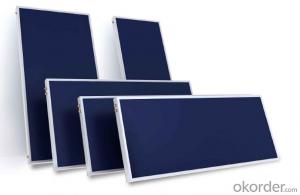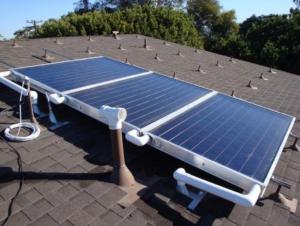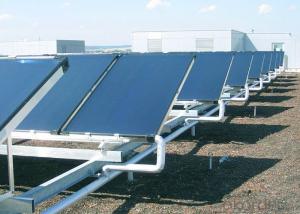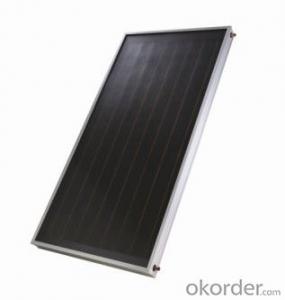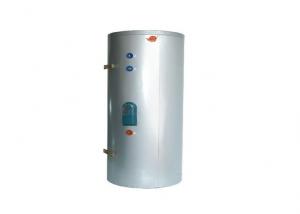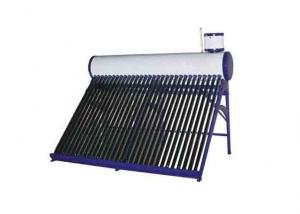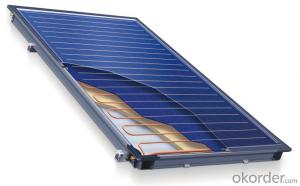Flat-Plate Solar Collectors - Separated Flat Plate Solar Thermal Collector
- Loading Port:
- Shanghai
- Payment Terms:
- TT OR LC
- Min Order Qty:
- 500 pc
- Supply Capability:
- 10000 pc/month
OKorder Service Pledge
OKorder Financial Service
You Might Also Like
Specifications
Sunshore non pressure solar collector
CE, Solar keymark certificate
Low pressure, high efficiency. low cost
Commercial use
Sunshore vacuum tube non pressure solar collector
Detail of material:
Outer tank: Al-Zn coated steel sheet
Inner tank: SUS 304-2B stainless steel sheet
Insulation: Polyurethane foam
Vacuum tube: Borosilicate glass 3.3
Absorption coating: Al-N-Cu-SS
Stand: Aluminum Alloy/Galvanized sheet
Feature of Flat Plate collector:
1.using patent advanced coating technology with high efficiency performance
2.High strength aluminium-alloy structure with surface varnish baking
3.High visual shape, easy installation, maintenance free
4.Pressurized designing, operate with pressure up to 1 MPa
5.Can be combined with existing energy
Features:
Copper pipes and fins
Blue Vacuum Coating
American ultrasonic welding
Tempered glass cover
Size: 2000*1000*90mm
Advantages:
Great pressurization property, very safe and clean.
Absorption ≥95%; emission ≤5%.
Strong thermal stability.
Strong welding property and conductivity.
Strong protection to the collector.
Benefits:
Durable and corrosion-resistant material makes your maintenance cost low.
Comfortable hot water can be gained even in medium solar radiation areas.
Increases the value of your property.
Long lifespan to 25 years, makes your investment more worth it.
Worry-free from hails or other terrible weathers.
Product advantage
Solar energy (Solar) generally refers to the Sun's radiant energy which is used as the modern general power generation. The water tank adopts stainless steel SUS304 food grade material, Corrosion resistance and durable .The brackets Using aluminum alloy material,USES the word "people" streamlined support, and combine the water tank, strong and durable .The vacuum tube is made of high quality high borosilicate, hard glass production,Good light transmittance,Heat faster Heat preservation is better. Our company can produces its own water tank bracket and vacuum tubes,Its products over the years committed to technology innovation,So the quality and service guaranteed and there are quite a preferential price.So many advantages is your best choose!
How it works
The design of this type uses the all-glass evacuated solar collector tubes as the heat absorb element. The high vacuum degree of the clearance between the outer and inner tube can reduce the heat emission which caused by convection and conduction to a very low level. All-glass evacuated tube transfers sun energy into heat energy by high absorption rate and low emittance rate of layer films. Depend on the different density between the hot water and the cold water, a cycle created in the tube which hot water ascending and cold water descending status. Keeping natural circulation like this, the water in the tank will be heated. Flat plate collectors are an extension of the basic idea to place a collector in an 'oven'-like box. Here, a pipe is connected to the water tank and the water is circulated through this pipe and back into the tank. The water tank is now outside the collector that only contains the pipes. Since the surface-to-volume ratio increases sharply as the diameter of a pipe decreases, most flat-plate collectors have pipes less than 1 cm in diameter. The efficiency of the heating process is therefore sharply increased. The design of a flat-plate collector therefore typically takes the shape of a flat box with a robust glass top oriented towards the sun, enclosing a network of piping. In many flat-plate collectors the metal surface of the pipe is increased with flat metal flanges or even a large, flat metal plate to which the pipes are connected. Since the water in a flat-plate collector usually reaches temperatures much higher than that of an ICS, the problem of radiation of heat back to the environment is very important, even though a box-like 'oven' is used.
- Q: Are there any limitations to the angle of installation for solar collectors?
- Yes, there are limitations to the angle of installation for solar collectors. The optimal angle of installation for solar collectors is typically between 30 to 45 degrees, depending on the geographical location. This angle allows for maximum solar energy absorption throughout the year. However, if the angle is too steep or too shallow, it can result in decreased efficiency and reduced energy output. Therefore, it is important to consider the specific location and its solar radiation patterns when determining the angle of installation for solar collectors.
- Q: Can solar collectors be used for heating military installations?
- Yes, solar collectors can be used for heating military installations. Solar thermal systems can effectively capture sunlight and convert it into heat energy, which can then be used to provide heating for various purposes within military installations, such as heating water, buildings, or air. The use of solar collectors for heating not only reduces dependency on traditional energy sources but also offers a sustainable and environmentally friendly solution for meeting heating demands in military installations.
- Q: What is the difference between flat plate and evacuated tube solar collectors?
- The main difference between flat plate and evacuated tube solar collectors is the design and efficiency. Flat plate collectors consist of a flat panel with a dark absorber plate, covered by a transparent cover, while evacuated tube collectors are made up of rows of glass tubes, with each tube containing a copper or aluminum absorber. Flat plate collectors are more common and less expensive, but they are also less efficient compared to evacuated tube collectors. Evacuated tube collectors have a higher heat retention ability due to the vacuum insulation in the glass tubes, making them more efficient in colder climates or during cloudy weather. Additionally, evacuated tube collectors can capture solar energy at a wider range of angles compared to flat plate collectors, increasing their overall performance. However, the higher cost and more complex installation of evacuated tube collectors can be a limiting factor for some applications.
- Q: Can solar collectors be used for heating car service centers?
- Yes, solar collectors can be used for heating car service centers. Solar thermal technology can be employed to capture the sun's energy and convert it into heat, which can then be used for space heating or water heating purposes. By installing solar collectors on the roof or other suitable areas of the car service center, the captured solar energy can be utilized to provide heat, reducing reliance on traditional heating systems and potentially decreasing energy costs.
- Q: Can solar collectors be used for generating electricity on spacecraft?
- Yes, solar collectors can be used for generating electricity on spacecraft. In fact, solar panels are a primary source of power for most spacecraft as they convert sunlight into electricity through photovoltaic cells. This sustainable and efficient method allows spacecraft to operate in space where traditional power sources like fossil fuels are not viable.
- Q: How do solar collectors affect the carbon footprint of a building?
- Solar collectors can significantly reduce the carbon footprint of a building by harnessing renewable energy from the sun. By generating clean and sustainable electricity, solar collectors eliminate the need for fossil fuel-based power sources, which are major contributors to greenhouse gas emissions. Thus, the integration of solar collectors helps to decrease the carbon emissions associated with a building's energy consumption, making it more environmentally friendly and reducing its overall carbon footprint.
- Q: Are solar collectors suitable for all climates?
- Solar collectors are generally suitable for all climates, although their efficiency may vary depending on the amount of sunlight available. In regions with abundant sunlight, such as deserts, solar collectors can be highly effective. However, even in colder or cloudier climates, solar collectors can still provide a significant amount of energy. Additionally, advancements in technology have made solar collectors more adaptable to different weather conditions, making them a viable option in most climates.
- Q: Can solar collectors be used in areas with limited access to distribution networks?
- Yes, solar collectors can be used in areas with limited access to distribution networks. Solar collectors, such as solar panels, can generate electricity locally, reducing the dependency on centralized distribution networks. This makes them suitable for remote or off-grid locations where establishing or accessing distribution networks may be difficult or expensive.
- Q: Can solar collectors be used in space exploration?
- Yes, solar collectors can be used in space exploration. They are commonly used in spacecraft to generate electricity by capturing sunlight and converting it into usable energy. Solar panels are lightweight and reliable sources of power, making them ideal for extended missions in space where other energy sources may not be feasible.
- Q: Can solar collectors be used in airplanes?
- Yes, solar collectors can be used in airplanes. In fact, some aircraft are already equipped with solar panels to generate power for various systems onboard, such as lighting or auxiliary power. These solar panels help reduce reliance on traditional fuel sources and contribute to a more sustainable and eco-friendly aviation industry.
Send your message to us
Flat-Plate Solar Collectors - Separated Flat Plate Solar Thermal Collector
- Loading Port:
- Shanghai
- Payment Terms:
- TT OR LC
- Min Order Qty:
- 500 pc
- Supply Capability:
- 10000 pc/month
OKorder Service Pledge
OKorder Financial Service
Similar products
Hot products
Hot Searches
Related keywords
